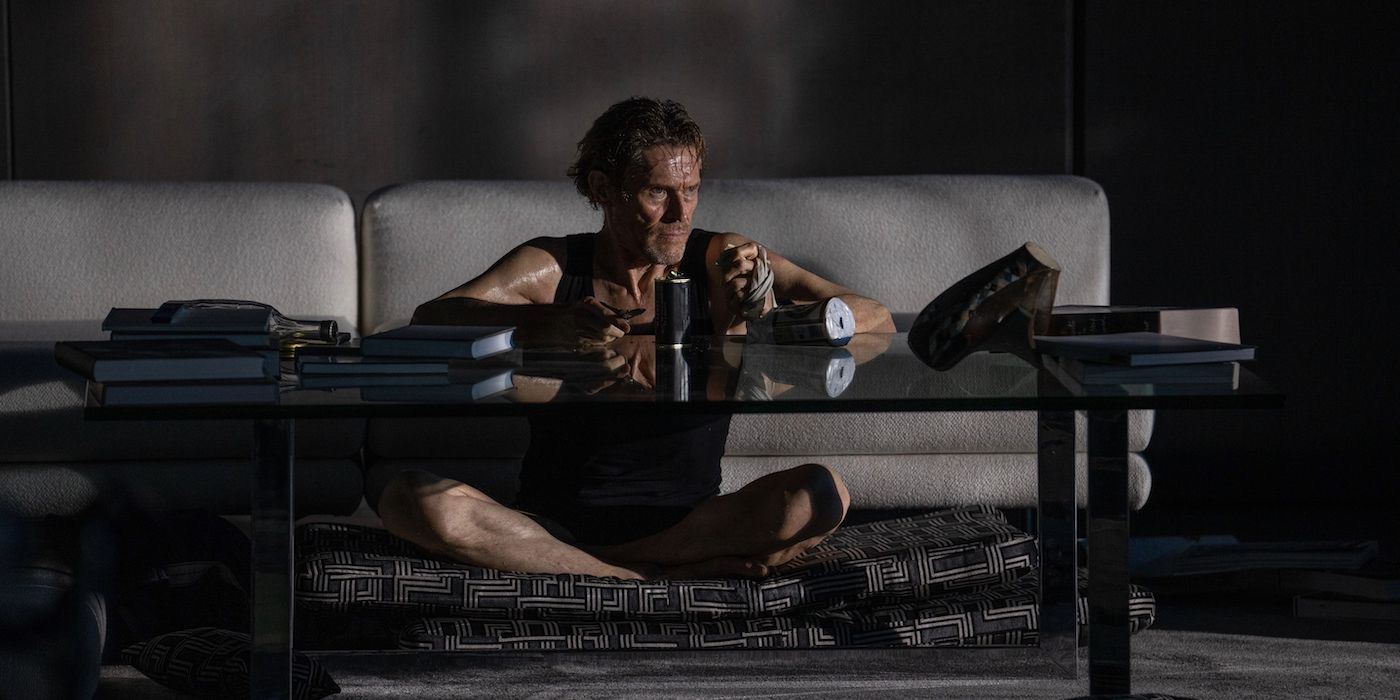What's the purpose of art? The most cynical among us might say it's to be used for tax evasion maneuvers, money laundry, and as investment assets for the wealthy – and we wouldn't be wrong. But there's also an undeniable force that pulls us all into creating meaning. Creation fascinates humans, from the most successful artists to a kid scrabbling a notebook. Still, when pushed to the brink of existence and forced to fight for survival, can we keep finding a reason for art to exist? Starring Willem Dafoe as art thief Nemo, Vasilis Katsoupis’ Inside is deeply concerned with these questions, while still managing to fit a complex discussion in the middle of a thriller that's equally tense and entertaining.
Inside follows Nemo as he's sent to steal some expensive artwork from the well-secured New York flat of an art collector. Unfortunately for Nemo, the apartment's security system goes haywire before he gets out with the loot, sealing every exit shut with unbreakable glass and thick metal locks. Ultimately, the robbery gone wrong condemns Nemo to a challenging stay inside a concrete cage. Nemo's support team abandons the thief as soon as things go south. And since the flat is more of a personal gallery than a living space, there's no way of telling when the apartment's owner might return. So, alone, trapped, and with no means of communicating with the outside, Nemo must figure out how to survive long enough so he can manage to escape.
It's easy to approach Inside as yet another pandemic-inspired film that shows the dangers of isolation. All the main elements of this growing subgenre are there, including Nemo's slow descent into madness as he's deprived of any human contact. But it would be a mistake to condense the movie into a single note, as Inside is, above all, about the intrinsic connection between art and the human desire to exist beyond the confines of time.
In Inside, Nemo tries to do whatever he can to stay alive, as would anyone else. Because as much as we are used to the everyday comforts of our lives, there's also primal energy pushing us to survive, making death and oblivion the biggest enemies of the human spirit. Pulling through won't be easy, though, as Nemo must get creative to find food, water, and shelter from a climate control that alternates between trying to cook and freeze the thief. That means Inside turns Nemo into the manifestation of human endurance, thrilling the audience as he beats the odds and keeps stretching his life, one day at a time. Katsoupis abuses close-up to show the details of Nemo’s suffering and grit, letting viewers observe drops of sweat running down Dafoe’s back or the actor’s lips cracking due to the extreme temperatures. In Inside, Dafoe’s body becomes the center of the movie’s bizarre art exposition as the ultimate representation of what the human will can achieve.
In Nemo’s dire situation, the priceless objects of art and decoration spread everywhere in the flat lose meaning. A short narration in Inside’s introduction underlines how Nemo recognizes the value of art as a projection of human perseverance. Nevertheless, when faced with death, Nemo won't hesitate to tear the flat apart, stripping art of its contemplative nature to turn it into a pragmatic survival tool. This destructive process is mesmerizing, as it reveals how even the most priceless work of art can be reduced to just a piece of metal, tissue, or paper, ready to feed Nemo's creativity as he tries to find emergency exits. On the threshold of existence, Nemo exposes the harsh truth that art, in itself, has no purpose, at least in the most material sense of the word.
Still, Inside doesn’t allow itself to offer catharsis by destroying rich people’s properties. The movie wants to take one step further and show how art is not obsolete. As he spends his days alone in the flat, Nemo still takes time to draw the things and people he sees through windows and cameras, using pen and paper to process his need for human affection. He also turns the fruits of his labor into pieces of altars and finds levity through rituals that only make sense as prolongations of his interior universe. In short, while Nemo is destroying the cold and static works of art he finds in the flat, he’s also creating art as an extension of his mind, leaving behind traces of his existence that will survive long after his flesh perishes. And that’s the true beauty of Inside, as the thriller becomes both a story about Nemo’s survival instincts and his desire to make art.
Art, as an object, doesn’t have a purpose. Art, as a testament to humanity's unique ability to cheat death, gives meaning to our fragile lives.
Inside can be approached by people looking for a new confinement thriller but willing to overthink its philosophy. But it also can give people interested in art many fresh and exciting ideas to discuss. Everything is glued together by another Dafoe performance that proves he’s one of the greatest actors of all time, especially when given enough room to tap into the lunacy of his characters. In short, Katsoupis managed to craft a crowd pleaser that still has something interesting to say.
Rating: A
Inside had its world premiere at 2023’s Berlin Film Festival.


